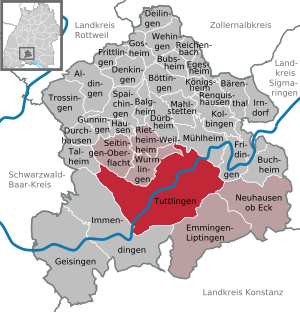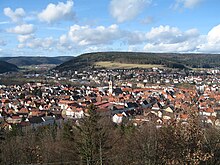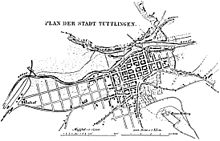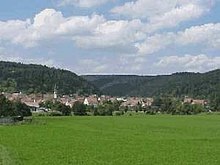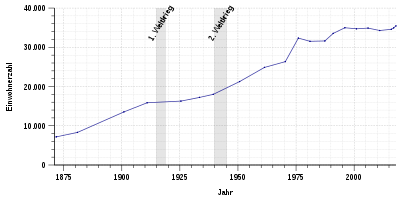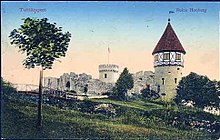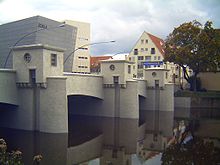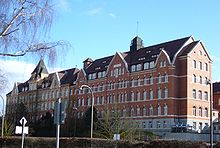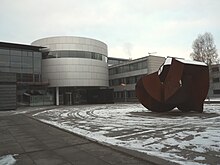Tuttlingen
| coat of arms | Germany map | |
|---|---|---|
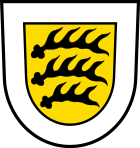
|
Coordinates: 47 ° 59 ' N , 8 ° 49' E |
|
| Basic data | ||
| State : | Baden-Württemberg | |
| Administrative region : | Freiburg | |
| County : | Tuttlingen | |
| Height : | 645 m above sea level NHN | |
| Area : | 90.49 km 2 | |
| Residents: | 35,730 (Dec. 31, 2018) | |
| Population density : | 395 inhabitants per km 2 | |
| Postal code : | 78532 | |
| Primaries : | 07461, 07462 , 07464 | |
| License plate : | DOES | |
| Community key : | 08 3 27 050 | |
| City structure: | Core city and 3 districts | |
City administration address : |
Rathausstrasse 1 78532 Tuttlingen |
|
| Website : | ||
| Lord Mayor : | Michael Beck ( CDU ) | |
| Location of the city of Tuttlingen in the Tuttlingen district | ||
Tuttlingen is a city in the south of Baden-Württemberg . It is the district town and largest city in the district of Tuttlingen as well as a middle center within the Schwarzwald-Baar-Heuberg region , whose central area includes all 36 cities and communities in the district. Tuttlingen has been a major district town since April 1, 1956 . The next larger town, Villingen-Schwenningen, is about 30 kilometers northwest of Tuttlingen.
Due to the more than 400 medical technology companies with around 8,000 employees, Tuttlingen is often referred to as the "world capital of medical technology".
Settlement geographical classification
Tuttlingen lies in the valley of the Upper Danube on both sides of the still young river.
The city was built at the foot of Honbergs, a revolving mountain of ancient Danube , which here by the limestone formations made her way. Today the city completely encloses the mountain. Although Honberg Castle was completely destroyed by the people of Tuttlingen, the rebuilt monument with its two characteristic towers has become the city's landmark.
The highest point of Tuttlingen is in the district of Eßlingen at 927.4 m above sea level. NHN , the lowest in the Nendingen district with 633.7 m .
Neighboring communities
The following cities and communities border the city of Tuttlingen. They are called clockwise starting in the northeast:
Mühlheim , Fridingen , Neuhausen ob Eck , Emmingen-Liptingen , Immendingen , Talheim , Seitingen-Oberflacht , Wurmlingen (all Tuttlingen districts ).
City structure
The urban area consists of the core town and the town of Möhringen , which was incorporated as part of the community reform of the 1970s, and the formerly independent communities of Nendingen and Eßlingen.
The unincorporated neighborhoods are also towns within the meaning of § 67ff of the Municipal Code , that is, they each have one of the persons entitled to vote in local elections to be elected directly Ortschaftsrat with a mayor as chairman.
Some parts of the city have further spatially separated residential areas with their own names, which often have very few residents, or residential areas with their own names, whose names have emerged in the course of development and whose boundaries are usually not precisely defined. In detail, these are the following areas:
- to the core city: Aichhalder Hof, Äußerer Talhof, Bleiche, Gallertalhof, Innerer Talhof, Koppenland , Lohhof, Ludwigstal , Maiental, paper mill, Wenigsbronner Hof, Württemberger Hof
- to Möhringen: Brunnerhof, Engelberthof, Lindenhof, Möhringen-Vorstadt
- to Nendingen: Altental , Neumühle
history
Ancient and Middle Ages

In early history, the area around Tuttlingen was probably located in the settlement area of the Celtic Tulingers , who from 15 BC onwards. Were subjugated and romanized by the Roman Empire . As part of the later Roman province of Upper Germany , the region lay on the Upper German-Raetian Limes on the Donausüdstraße ( via iuxta Danuvium ) until around 95 AD . At that time, there was probably a fort in the area of today's Tuttlingen old town . Due to the dense settlement of the area nowadays, excavations have not been carried out so far, so that very little is known about the Tuttlingen fort . After the withdrawal of the Roman legions, the Suebi and / or Alamanni settled in the local area.
In the Middle Ages , Tuttlingen was first mentioned in a document in 797 and a short time later it belonged to Reichenau Monastery . The place received city rights before 1338 and belonged to Württemberg since 1376/77 .
With the construction of the fortress on the Honberg, Tuttlingen was expanded by Eberhard im Bart around 1460 to become a first-rate border fortress .
Early modern age
As a fortified southern outpost of Württemberg, it was always fought over during the Thirty Years' War . The main event was the battle of Tuttlingen on November 24, 1643 , in which the entire French army was wiped out by the united imperial-Bavarian troops under Melchior Graf von Hatzfeldt , Franz von Mercy and Johann von Werth .
In 1703 a French army of around 35,000 men crossed the Rhine again during the War of the Spanish Succession under Marshal Villars , took the Kehl fortress and finally turned against the Kinzig valley. There were only 4,000 defenders of the Swabian Empire under the command of Prosper Ferdinand von Fürstenberg-Stühlingen . He recognized the hopeless situation and, with luck, was able to withdraw to Wolfach . Gengenbach , Zell am Harmersbach and Haslach were taken by the French, Hausach razed to the ground. The Wolfachers, however, were lucky. After some hesitation, Villars had his army march south through the Gutach Valley to Villingen. There he failed on May 4th and 5th a coup d'état on the inadequately fortified city. On May 12th he met the Bavarian troops under Elector Maximilian II Emanuel in Tuttlingen . In the same year they jointly defeated the imperial troops in the First Battle of Höchstädt .
Tuttlingen was already the seat of an upper bailiff's office and in 1755 it became the seat of a Württemberg upper office , which was changed several times in the course of its history.
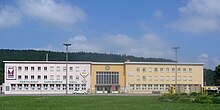
On November 1st, 1803, Tuttlingen burned down completely within the city walls . The city was rebuilt from 1804 onwards according to a plan by the master builder Carl Leonard von Uber with classicist, right-angled streets and square-style houses.
Tuttlingen after the city fire in 1803
Through the Rhine Confederation Act of July 12, 1806, Tuttlingen fell to the Grand Duchy of Baden together with the part of the Tuttlingen Oberamt on the right side of the Danube . However, in October of the same year, this area was re-incorporated into the Kingdom of Württemberg via the exchange and epuration agreement and, according to the administrative structure, confirmed as the seat of the Tuttlingen District Office. In 1830 the two Württemberg exclaves within Baden, Bruderhof (267 hectares) and Hohentwiel (116 hectares), were assigned to the Tuttlinger Stadtflur and from 1851 belonged to the city of Tuttlingen as sub-communities. This condition remained until the end of 1968 (see Württemberg exclaves ). The connection of the city to the route network of the Württemberg railway in 1869 was of decisive importance for the later industrial development . The former Tuttlinger train station was replaced by a new building in 1933.
During the Nazi era in Württemberg , the Tuttlingen Regional Office was renamed the Tuttlingen District in 1934. In 1938 the district was transferred to the Tuttlingen district , which was expanded to include the dissolved Spaichingen district . During the Second World War there were prisoner-of-war camps and forced labor camps in Tuttlingen , in which workers who were forcibly assigned to the local industry were housed. In February and March 1945, Tuttlingen experienced a total of five air raids , four of which mainly targeted the train station. On April 21, 1945, parts of the French 1st Army occupied the city. Tuttlingen thus became part of the French zone of occupation . Railway bridges were blown up and until 1952 the “Mühlau” POW camp, the “Dépôt de transit N ° 2”, was a transit and release camp for hundreds of thousands of German prisoners of war in the French occupation zone. Today the Immanuel-Kant-Gymnasium and the Otto-Hahn-Gymnasium are located on this site .
In 1947 Tuttlingen came to the state of Württemberg-Hohenzollern , in 1952 to the newly founded state of Baden-Württemberg and there in the administrative district of Südwürttemberg-Hohenzollern .
In 1949 the population had already exceeded 20,000. Therefore, when the Baden-Württemberg municipal code came into force on April 1, 1956, Tuttlingen was declared a major district town . The two Tuttlinger exclaves Bruderhof and Hohentwiel were incorporated into the town of Singen (Hohentwiel) in 1967 and early 1969 respectively . During the district reform in 1973 , the district of Tuttlingen was expanded to what it is today, increasing the number of inhabitants by a third and the area by three times - at the same time, the district was now assigned to the Freiburg administrative district .
History of the districts
Möhringen was first mentioned in 786 as Mereingen. Around 973 the place came to the Reichenau, which lent it to various noble families. In the 13th century Möhringen was the seat of the Reichenau Bailiwick. Around 1300 Möhringen was probablyelevated to the status of cityby Heinrich von Klingenberg , Bishop of Constance. In the 15th century jurisdiction was also transferred to the Klingenbergs, who sold the town with the villages of Eßlingen and Ippingen to the Fürstenbergers in1527. In 1806 Möhringen came to Baden and initially belonged to the Oberamt Möhringen, from 1813 to the Amt Engen, from 1824 again to the Amt Möhringen, from 1844 again to the Amt Engen and after its dissolution in 1936 to the District Office Donaueschingen , from which the district Donaueschingen emerged in 1939. When it was incorporated into the city of Tuttlingen on January 1, 1973, Möhringen became part of the Tuttlingen district. Möhringen has had the title of "state-approved climatic health resort" since 1980.
Nendingen was first mentioned in 1092, but the place was probably founded much earlier. It was owned by the Counts of Nellenburg , who passed it on to the Hirscheck- Konzenberg and the latter to the von Wartenberg . Finally he came torule of Weitingen through the Counts of Zollern . In 1411 Nendingen was part of the Mühlheim rule , but numerous monasteries had property in the village. With Mühlheim Nendingen came to Württemberg in 1805 and was assigned to the Tuttlingen District Office.
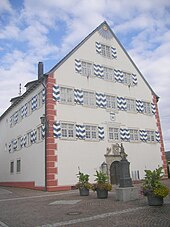
Eßlingen was first mentioned in 1225 as "Esselingen". As part of the Möhringen rule, the place came to the Principality of Fürstenberg in the 16th centuryand came to Baden in 1806. First Eßlingen belonged to the Oberamt Möhringen, from 1813 to the Amt Engen, from 1824 again to the Amt Möhringen, from 1844 again to the Amt Engen and from 1849 to the Amt or District Office Donaueschingen, from which the district of Donaueschingen emerged in 1939. When it was incorporated into the city of Tuttlingen on June 1, 1972, the place became part of the Tuttlingen district.
Incorporations
The following communities were incorporated into the city of Tuttlingen:
- June 1, 1972: Esslingen
- January 1, 1973: City of Möhringen and Nendingen
The town of Möhringen and the community of Eßlingen belonged to the Donaueschingen district before they were incorporated .
Population development
Population figures according to the respective area. The figures are census results (¹) or official updates from the respective statistical offices (main residences only).
|
|
¹ census result
religion
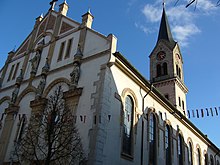
Tuttlingen initially belonged to the diocese of Constance and was assigned to the archdeaconate “ante nemus” (chapter Meßkirch). As a result of belonging to the Duchy of Württemberg, the Reformation was introduced here, as in the rest of Württemberg, from 1535 onwards by Ambrosius Blarer on behalf of Duke Ulrich . After that, Tuttlingen was a predominantly Protestant city for many centuries. It soon became the seat of a deanery (see Tuttlingen church district ) within the Evangelical Church in Württemberg . The main Protestant church is the city church of St. Peter and Paul (also: city church), originally a small chapel that was expanded several times and became a parish church after the Reformation. The previous parish church was Martinskirche, which was located in front of the town by the previous rural settlement of Tuttlingen. It was destroyed in the Battle of Tuttlingen in 1643 and replaced by a small chapel in 1862. The town church burned down in the town fire in 1803 and was then rebuilt. When the community grew rapidly due to the influx of people, the Martinskirche was built in 1958, the Resurrection Church in 1966 and the Reconciliation Church in the Lohmehlen residential area in 1986. Several pastors work at the four churches. Together with the Wurmlingen Church of the Redeemer, the congregations form the Evangelical General Church Congregation of Tuttlingen.
The districts of Tuttlingen remained predominantly Catholic as they belonged to Fürstenberg or to the Johanniterkommende Villingen. But there are also Protestant parishioners there today. In the Eßlingen district, they initially belonged to the parish of Öfingen ( Evangelical regional church in Baden ), but were re-parish in 1977 to the parish of Talheim (Württemberg). The Möhringen Protestants initially belonged to the parish of Immendingen, but there has been its own church since 1952 and now also its own parish. The Protestants from Nendingen belonged to the Mühlheim parish until 2010, and from January 1, 2011 they were integrated into the Tuttlingen town church. In Nendingen there has been its own church "Christ's Crib" since 1970. Since the Eßlinger Protestants were assigned to the parish of Talheim, all Protestant residents in the city of Tuttlingen belong to the Evangelical Church in Württemberg.
In the 19th century, Catholics moved to Tuttlingen again. The Catholic Church of St. Gallus was built from 1868 to 1872, and was made a parish in 1873. After the construction of the Maria Königin church in 1961, a second parish was established there in 1965.
In Nendingen, the local Catholic Church has been maintained by the Johanniterkommende Villingen since 1366. In place of the old church, today's church of St. Peter and St. James was rebuilt in 1755. The tower was not added until 1863. The parishes in Nendingen and the two Tuttlingen Catholic parishes belong to the Tuttlingen-Spaichingen deanery of the Rottenburg-Stuttgart diocese .
The Catholic communities in Eßlingen and Möhringen, however, belong to the Donaueschingen deanery of the Archdiocese of Freiburg , because both communities belonged to Baden from 1806 . The Eßlinger church of St. Jakob the Elder and Andreas was built in 1494 and enlarged in 1854. The church of St. Andreas Möhringen was built at the end of the 16th century, but there was already a church before. The tower was added in 1934.
In addition to the two large churches, there are also free churches in Tuttlingen , including the Methodist Church (Immanuelskirche). The New Apostolic Church and Jehovah's Witnesses are also represented. Especially by younger immigration came Islam to Tuttlingen, so today three Muslim communities, the Merkez Camii the Turkish religious authority , a Bosnian is Muslim community and the Albanian-speaking community with mosque.
Denomination statistics
According to the 2011 census , in 2011 36.8% of the population were Roman Catholic , 27.6% Protestant and 35.6% were non-denominational , belonged to another religious community or did not provide any information. The Tuttlingen population currently (as of December 31, 2019) belongs to 31.2% (11,429) of the Roman Catholic and 20.8% (7,610) of the Protestant Church. 48.0% (17,597) of the population belong to other or no religious groups.
politics
Municipal council
The local elections on May 26, 2019 led to the following result:
| Party / list | Share of votes | Seats | +/- |
| CDU | 31.5% | 12 | - 1 |
| SPD | 15.9% | 6th | - 1 |
| LBU | 25.6% | 9 | + 2 |
| FWG | 12.0% | 4th | ± 0 |
| FDP | 8.8% | 3 | ± 0 |
| Animal Welfare Alliance | 3.3% | 1 | + 1 |
| AfD | 1.4% | 1 | + 1 |
| Tuttlinger List (TL) | 1.7% | 1 | + 1 |
mayor
At the head of the city of Tuttlingen had been the "twelve" since the 14th century, to which the mayor, the mayor and ten other members of the court belonged. There were also twelve council members. Later, the Tuttlinger Oberamtmann appointed by the rulers was also mayor of the city. From 1822 there was an elected city school and the municipal council.
The mayor of Tuttlingen currently has the official title of " Lord Mayor ". Today he is directly elected for a term of eight years and is chairman of the local council. His general deputies are the 1st alderman (since 2006 Emil Buschle, CDU) with the official title "First Mayor" and the 2nd alderman with the official title "Mayor" (since 2006 Willi Kamm, SPD).
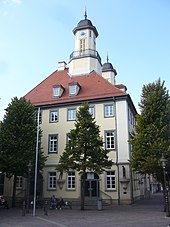
- Mayor of Tuttlingen since 1829
- 1829–1866: Jakob Friedrich Schnekenburger , Stadtschultheiß
- 1866–1876: Julius Friedrich Walter Schad , Stadtschultheiß
- 1877–1903: Christian Storz , Stadtschultheiß
- 1903–1908: Julius Keck , Lord Mayor
- 1908–1938: Paul Friedrich Scherer , Lord Mayor
- 1938–1945: Max Haug , Mayor
- 1945: Gustav Zimmermann , acting mayor
- 1945–1946: Franz Heinkele , acting mayor
- 1946: Fritz Fleck (SPD), acting mayor
- 1946–1951: Otto Fink (CDU), mayor
- 1951–1980: Walter Balz (SPD), mayor until 1952, then mayor
- 1980–2004: Heinz-Jürgen Koloczek (CDU), Lord Mayor
- since 2004: Michael Beck (CDU), Lord Mayor
Administrative community
The city of Tuttlingen has entered into an agreed administrative partnership with the communities of Emmingen-Liptingen , Neuhausen ob Eck , Rietheim-Weilheim , Seitingen-Oberflacht and Wurmlingen .
Finances
According to the 2017 budget, the city of Tuttlingen had a debt level of EUR 14.6 million as of December 31, 2017. The current expenditure of 97.2 million euros was offset by income of 95.7 million euros, 33.8 million euros of which was trade tax.
Coat of arms and banner
| Blazon : "In the golden, silver bordered shield, three black stag poleslying ontop of each other" | |
| Justification for the coat of arms: A lily was depicted in the city's seals since the 18th century . This is a symbol on landmarks. Before that, however, only the stag from the Württemberger were shown. This was placed in a larger shield in the 16th century, which is why you can find a bordered shield today. This seal then established itself as the city's coat of arms. The lily coat of arms was then no longer used. |
The flag is blue and yellow. It is shown with and without a coat of arms.
Town twinning
Tuttlingen has been twinned with Bex in the canton of Vaud (Switzerland) since 1979 and with Draguignan in France since 1989.
On July 1, 2006, the “50 years town twinning” anniversary was celebrated in the Möhringen sub-community. Möhringen's first twin town was Bischofszell in the canton of Thurgau (Switzerland) in 1956 ; In the same year the Austrian Waidhofen an der Ybbs and Battaglia Terme near Padua in Veneto (Italy) followed. As part of the anniversary, a new partnership association was established, which now includes the six European cities of Bex, Draguignan, Bischofszell, Battaglia Terme, Waidhofen an der Ybbs and Tuttlingen.
Culture and sights
Tuttlingen is on the Swabian Albstraße . The municipality is affiliated with the "Donaubergland" tourist association.
City Hall
The town hall is a cultural center in Tuttlingen. Theater and concerts, both classical and pop & rock, are concentrated in this place. When the old festival hall at the Stadtgarten became too small to attract artists of international greatness, after a competition in 1997 to 2002 at the Wöhrdenbrücke by the Stuttgart architects' partnership Heckmann. Kristel. Jung built the new town hall.
Museums and gallery
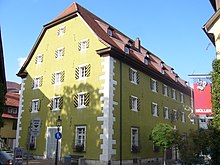
- City history museums: In the Fruchtkasten and in the Tuttlinger Haus in the city center there are city history museums with considerable equipment.
- German Steam Locomotive and Model Railway Museum: In the former railway depot in the Möhringen district, at the old roundhouse, Tuttlingen offers a picturesque railway museum with a turntable and 26 historic steam and diesel locomotives and wagons.
- Gallery of Tuttlingen: The gallery of the city of Tuttlingen shows monthly changing exhibitions mainly of contemporary art from home and abroad in an architecturally appealing ambience.
Other cultural institutions
- library
- City Archives
- ZEBRA youth art school of the city of Tuttlingen
- Music school of the city of Tuttlingen
- Sociocultural Center Rittergarten e. V.
- Kulturhaus Old Crematorium
Memorials
In 1947, a memorial was set up in the cemetery for victims of National Socialism, among whom were victims of the " euthanasia " campaign T4 . They are remembered on six stone tablets. Numerous corpses from Tuttlingen and the surrounding area were cremated in the city's crematorium , including murdered and perished concentration camp prisoners from the regional concentration camp subcamps. An obelisk commemorates their fate .
In May 2016, the first five Stolpersteine were laid in the pedestrian zone , and 17 more followed in October 2017.
Buildings
The Protestant town church gives the townscape something characteristic. Since the city center burned down completely in 1803, there are no historical buildings. The city church was built with great effort and with many donations and is a ray of light in the otherwise rather simple inner city. Its richly structured Art Nouveau facade is considered one of the most beautiful in southern Germany.
The Catholic parish church of St. Gallus was built by Georg Morlok from 1869 to 1873 and rebuilt from 1937 to 1939. Other churches are the Evangelical Martinskirche (1958), the Evangelical Resurrection Church (1968) and the Evangelical Church of Reconciliation and the Catholic Church of Mary Queen (1961/63).
The late medieval Honberg Castle was destroyed to the ground in the Thirty Years War. The two towers, which are now symbols of the city, could only be rebuilt in the 19th century through donations on the initiative of a support association. The extensive remains of the wall of the fortress are now home to events such as the Honberg summer and offer the best view of the city center. Another castle ruin is the Luginsfeld castle ruin , located in the northeast of the city center on the southwest tip of the Leutenberg.
Tuttlinger Hut describes a roof shape typical for the city. It is a hipped roof variant that is supposed to protect against a city fire. When the city center was redesigned after the city fire in 1803, this special roof shape became the standard for the city center.
In the districts there are old Catholic and two new Protestant churches (see section Religions).
Regular events
- In the summer months, the Honberg summer takes place for three weeks with international artists whose repertoire ranges from jazz to rock & pop to alternative.
- Since 2001, the city of Tuttlingen has been awarding the Southwest German cabaret “ Tuttlinger Krähe ”, a prize worth € 7,000 with over 100 applicants for the final round.
- The folk festival takes place annually in May / June.
- The Tuttlinger Herbst consumer fair takes place every two years in autumn .
- Since 1976 there has been an annual carnival parade on Mardi Gras Saturday.
- In June, the Southside Rock Festival with many international bands takes place on the former army airfield in the neighboring community of Neuhausen .
- Since 2008, the Summer in the Park series of events has been held annually in the Donaupark in July and August .
- A Christmas market takes place on nine days in December .
- The TuttlingerNachtKultour on the last Saturday in the summer holidays opens every two years and a. the cultural institutions of the city, the churches, the bookstore, the district office and the knight's garden and offers a diverse range of 20-minute "cultural snacks" under the starry sky.
- Since 2004, the "Tuttlinger Literaturherbst" has been held every year on several evenings in October / November with readings by well-known authors.
- The city's gallery shows 9 exhibitions of contemporary art every year.
- Every year at the end of January / beginning of February the music school organizes the regional competition Jugend musiziert for the districts of Tuttlingen, Rottweil and Schwarzwald-Baar in cooperation with the German Music Council .
- The Baden district of Möhringen is known for its Swabian-Alemannic carnival . The Scherbel groups that go through the bars on the "Fasnetsunntig" and "Fasnetsmändig" in the evening and the Hanselerennen at noon of the "Fasnetszieschdig" are well worth seeing.
- Also in Möhringen there is the tour of the " night watchmen with their servants".
- In the years with an even number, the “Städtlefest” of all clubs takes place in Möhringen at the beginning of July.
freetime and sports
Tuttlingen has 56 sports clubs (as of 2020):
- The SC 04 Tuttlingen is best known for the football department and also offers futsal, gymnastics, athletics and a cardiac sports group
- The Athletics-Sport-Association 1897 Tuttlingen has 7 departments (wrestling, boxing, weightlifting, karate, scuba diving, fitness & leisure as well as kickboxing) and over 500 members; The Bundesliga derbies with ASV Nendingen are legendary in the field of wrestling , today the club is active in the association league
- The Turngemeinde Tuttlingen 1859 eV has basketball, fencing, handball, inline sports, athletics, swimming, gymnastics, dance, gymnastics and volleyball in its program
- The Tuttlinger Sportfreunde e. V. 1965 specialize in badminton, beach volleyball, fitness, health sports, running clubs, tennis, triathlon and volleyball
Economy and Infrastructure
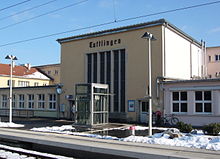

traffic
The station Tuttlingen is a regional railway junction where the railway line Stuttgart-Tuttlingen on the railway line Tuttlingen-Inzigkofen and the railway Tuttlingen-Hattingen hits. On the Gäubahn is Tuttlingen maintenance of the two-hour clock trains running intercity trains between Stuttgart and Zurich . In addition, the regional express trains from Singen to Stuttgart stop in Tuttlingen, which run every two hours , so that fast connections to Stuttgart and Singen are offered every hour. Interregio-Express trains run every two hours between Ulm and Neustadt (Black Forest) . In addition, Tuttlingen is connected to the Ringzug system, which connects Tuttlingen with Zollhaus- Blumberg , Fridingen an der Donau and Rottweil . Overall, Tuttlingen has a good range of rail transport options with a combination of long-distance transport, fast local transport and ring train. Today's Tuttlinger Bahnhof was built in 1933 and is located outside of the Tuttlingen city center. City buses connect the train station with the bus station in the city center. In addition to the Tuttlingen train station, with its outstanding importance as a railway junction and long-distance train station, the city of Tuttlingen also has a total of seven further ring train stops and is the starting point for numerous bus routes. Tuttlingen is part of the TUTicket transport association .
The next motorway connections are Geisingen or Tuningen and lead to the federal motorway 81 (Stuttgart – Singen). The Kreuzstrasse tunnel , which opened on February 17, 2011, leads federal road 311 (Ulm – Donaueschingen) and federal road 14 ( Stockach –Rottweil) together through the west of the city from Alexanderstrasse to near Aesculap-Platz.
Tuttlingen is connected to a number of long- distance cycle routes, including the European long-distance cycle route EuroVelo EV6, which runs from the Atlantic to the Black Sea, and the Danube Cycle Route .
Companies
Over 1900 companies have their headquarters in Tuttlingen - from one-man operations to multinational companies . Due to the large number of leading surgical companies in and around Tuttlingen, the city sees itself as the “world center of medical technology” (around 600 companies are directly involved in the manufacture of surgical and medical technology products). The medical technology companies are closely linked with the medical technology cluster in the Sialkot district of Pakistan .
Mechanical engineering and the building trade are also important employers. Until a few years ago, Tuttlingen was also known as the “ shoe city”. The shoe industry settled on the Danube due to numerous tanneries , of which only a few still exist today. The tanning trade in Tuttlingen enjoyed good conditions thanks to the Danube and the widespread cattle farming. Cattle breeding dominated agriculture due to the poorly fertile soil and the cultivation areas that were often flooded in spring.
List of important Tuttlingen companies
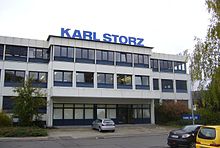
- The Aesculap AG is the oldest and most prestigious companies in the surgical industry in Tuttlingen; it has been owned by B. Braun Melsungen AG since 1998 . Aesculap is the largest employer in Tuttlingen; the company's buildings shape the cityscape at the station. The large roundabout where the federal highways 14 and 311 intersect is called Aesculap-Platz ; it is now completely surrounded by company buildings. In the south it is adorned by the old factory and main building. To the left of this is the Aesculapium (the company's presentation and information facility). Sales and technical services follow.
- Karl Storz (specialized in endoscopy)
- Henke-Sass, Wolf (medical and technical endoscopes, syringes, veterinary products, flow measurement technology)
- Gebrüder Martin (Sales Medical Technology)
- Berchtold GmbH & Co. KG (medical technology)
- Chiron works (mechanical engineering, CNC machines)
- Swabian smelting works , Ludwigstal (brake discs)
- Rieker (shoe manufacturer)
- Stadtwerke Tuttlingen (energy and water supply)
- Smith & Nephew (medical technology), production facility in Tuttlingen
- Volksbank Black Forest-Danube-Neckar
- Storz & Bickel (medical technology)
- C. Bruno Bayha GmbH (medical technology)
The medical technology industry has had a cluster management system called MedicalMountains since 2011 . The initiative to secure the location, founded by the IHK Schwarzwald-Baar-Heuberg , the district of Tuttlingen and the regional company Biopro Baden-Württemberg , offers a network to promote innovations and strengthen the international competitiveness of small and medium-sized companies. The company is a prizewinner in the cluster competition of the Ministry of Finance and Economics Baden-Württemberg and is funded by the European Regional Development Fund (ERDF) and the Ministry of Finance and Economics Baden-Württemberg.
In the medical technology exhibition ACIG (exhibition of surgical instruments and devices) around 70 small and medium-sized companies from medical technology present their products to specialist buyers from all over the world. The exhibition is open all year round, accessible to everyone and admission is free. In addition, the ACIG publishes a new edition of the reference source reference book Der Chirurgieführer with currently over 150 companies every November .
Court, authorities and institutions
Tuttlingen is the seat of the Tuttlingen district. There is also a tax office , a notary's office and a district court , which belongs to the regional court district of Rottweil and the higher regional court district of Stuttgart.
The city is also the seat of the Tuttlingen church district of the Evangelical Church in Württemberg and the Tuttlingen-Spaichingen deanery of the Rottenburg-Stuttgart diocese .
media
The daily newspaper of the Gränzbote , a local edition of the Schwäbische Zeitung, reports on local events in Tuttlingen . The radio station Radio 7 has a studio in the city. Since 2005, the regional television broadcaster Regio TV Bodensee has also been broadcasting on the local cable network, via satellite and live stream.
Educational institutions
Tuttlingen has two grammar schools (the Otto Hahn grammar school and the Immanuel Kant grammar school ), two secondary schools (Hermann Hesse secondary school and Ludwig Uhland secondary school), a special education and advice center with a focus on learning (Albert Schweitzer School), a community school with elementary school (Wilhelmschule), six elementary schools (elementary school in Holderstöckle, elementary school Karlschule, Schildrainschule, Schrotenschule, Anton-Braun-Grundschule Möhringen and Danube school Nendingen ) as well as a Werkrealschule (Schillerschule).
The city of Tuttlingen also maintains the music school and the ZEBRA youth art school.
The Tuttlingen district is responsible for the Ferdinand-von-Steinbeis-Schule (commercial school, including a technical high school ), the Fritz-Erler-Schule (formerly commercial and home economics schools, including an economics , nutritional, biotechnological and social science high school) , the health and nursing school of the Tuttlingen and Spaichingen district clinics and the Johann-Peter-Hebel-Schule for children and young people with intellectual disabilities.
The private Gotthilf Vollert school for educational assistance and the private school kindergarten for children with intellectual disabilities round off the school offerings in Tuttlingen.
A new campus as a branch of the Furtwangen University was set up for the 2009/2010 winter semester. It starts operations with the new technical courses Industrial medtec , Industrial Systems Design and Industrial Manufacturing , each with 35 student places . For this purpose, cooperation agreements have been concluded with the economy in Tuttlingen.
Leisure and sports facilities
- Leisure and thermal bath " TuWass " with a state-approved mineral spring and a spacious sauna area
- “Scala” cinema palace - modern open-plan cinema with 5 halls
- Danube Park in the middle of the city center with a large open-air skate park, children's playgrounds, mini golf course, Momo garden, gardens of the twin cities, sports fields and differently designed bank areas. The Donaupark was created in 2003 for the "Trilogy 2003" as a green project of the state of Baden-Württemberg and the city of Tuttlingen.
- Outdoor pool (completely overhauled in 2005/2006) with several slides, a lazy river and other attractions
- Ski slopes in Möhringen and Nendingen as well as in the neighboring villages of Wurmlingen (without lift) and Emmingen or near Böttingen (with lift)
Personalities
Honorary citizen
The city of Tuttlingen has granted the following people honorary citizenship:
- 1888: Johann Gottfried Stengelin, founder of the foundation
- Christian Storz , city school hot
- 1927: Christian Scheerer, councilor and co-founder of the Aesculap company , formerly Jetter and Scheerer
Honorary gift of Kannitverstan
The highest award currently awarded in the city is the Kannitverstan . It is the counterpart to honorary citizenship, which is no longer awarded. At the moment he has:
- Aimé Dezarens (1990)
- Otto Wichert (1990)
- Karl-Werner Bolzer (1995)
- Michael Ungethüm (2002)
- Erich Weber (2002)
- Heinz-Jürgen Koloczek (2003)
- Sybill Storz (2005)
- Dieter Egle (2007)
- Anthia Peter and Kreszentiana Schips (2008)
- Volker Kauder (2010)
- Ortwin Guhl (2014)
- Herbert Moser (2014)
- Roland Martin (2017)
sons and daughters of the town
- Heinrich Abermann (1583–1621), historian
- Michael Alber (* 1963), conductor, first choir director at the Stuttgart State Opera
- Klaus Bacher (* 1964), judge at the Federal Court of Justice
- Ernst Bärtschi (1903–1983), Swiss escape helper
- Bernhard Beck (* 1954), lawyer and board member of EnBW Energie Baden-Württemberg
- Anne Birk (1942–2009), writer
- Reinhold Böhme (1944–2000), mathematician
- Bernhard Braun (1929–2009), football player
- Peter Braun (* 1962), middle-distance runner
- Fritz Buschle (* 1951), SPD politician, member of the state parliament
- Felix Czerny (* 1984), basketball player and trainer
- Hermann Dold (1892–1953), entrepreneur and politician (CDU), member of the state parliament
- Frank Druffner (* 1959), art historian, deputy general secretary of the Kulturstiftung der Länder
- Heinz Eyrich (1929–2015), lawyer and politician with the CDU
- Gerhard Fezer (1938–2014), lawyer and university lecturer
- Christoph Frick (* 1960), theater director
- Walter Gmelin (1863-1943), veterinarian
- Johann Georg Gödelmann (1559–1611), law professor, diplomat and witch theorist
- Gordon November (* 1985, real name Gordon Sven Buschle), songwriter, singer and pianist
- Klaus Hopt (* 1940), business lawyer and former director at the Max Planck Institute
- Andreas Huber (* 1981), speaker, managing director of the German Society Club of Rome
- Gottfried Jetter (1838–1903), entrepreneur and founder of the Aesculap works
- Rainer Kling (* 1952), amateur astronomer and asteroid discoverer
- Paul Knapp (1879–1953), Protestant pastor and pacifist , founder of the German Peace Party
- Reiner Kohler (1944–1995), travesty artist "Gordy" of the well-known duo Mary & Gordy
- Hildegard König (* 1954), Roman Catholic theologian and university professor
- Ulrich Kuder (* 1943), art historian
- Jürgen Lässig (* 1943), racing car driver
- Adolf Laufs (1935–2014), legal scholar, Rector of Heidelberg University (1979–1982)
- Gustav Lotterer (1906–1987), composer, arranger and conductor
- Joy Markert (* 1942), writer, radio play and screenwriter
- Roland Martin (* 1927), sculptor
- Hermann Mattheiß (1893–1934), SA leader and policeman as well as one of those killed in the so-called Röhm putsch
- Friedrich Christoph Mayer (1762–1841), born in Ludwigstal, imperial knightly bailiff, later Grand Ducal Hessian court advisor
- Herbert Moser (* 1947), SPD politician, 1976–1992 and 1996–2006 Member of the Baden-Württemberg State Parliament, Ministerialrat, Managing Director of the Baden-Württemberg State Foundation
- Ernst August Friedrich Rechfuß (1779–1854), member of the Württemberg state parliament
- Helmut Rühl (* 1955), actor
- Karl-Heinz Rühle (* 1942), physician, university professor and specialist author
- Hans-Ulrich Rülke (* 1961), politician (FDP), member of the state parliament
- Erich Schariry (1892–1974), District Administrator of the Tuttlingen District (1946–1947)
- Richard Scheerer (1887–1982), ophthalmologist, university professor
- Wilfried Schlagenhauf (* 1952), teacher, university professor
- Hariolf Schlichtig (* 1950), member of the Cherubini Quartet for 19 years, soloist and since 1987 professor for viola and chamber music at the State University for Music and Theater in Munich
- Lisa Steinkamp (* 1990), track and field athlete
- Dietlinde Stengelin (* 1940), artist
- Hermann Stengelin (1871–1948), member of the Württemberg state parliament
- Friedrich Steudel (1866–1939), theologian
- Hermann Adolf von Stock (1809–1871), theologian, general superintendent of Heilbronn
- Christian Storz (1832–1907), member of the Württemberg state parliament
- Christian Storz (1865–1943), member of the Reichstag and Landtag
- Hans-Peter Storz (* 1960), Member of Parliament in Baden-Württemberg (SPD)
- Johannes Storz (1830–1918), member of the Württemberg state parliament
- Karl Storz (1911–1996), entrepreneur
- Wolfgang Storz (* 1954), former editor-in-chief of the Frankfurter Rundschau (2002–2006)
- Clemens Stroppel (* 1959), Vicar General of Rottenburg-Stuttgart
- Frank Teufel (* 1966), sculptor
- Maria Teufel (1888–1972), wife of Reinhard Teufel, founded the “Reinhard and Maria Teufel Foundation” with her husband to promote the academic education and training of highly talented young scientists in the fields of law and biology at Eberhard Karls University of Tübingen
- Reinhold Teufel (1890–1974), district court director and district court president
- Johann Konrad von Teuffel (1799–1854), lawyer and politician
- Wolfgang Volz (* 1948), photographer, mainly through its collaboration with the artist couple Christo and Jeanne-Claude known
- Laura Weihenmaier (* 1991), volleyball player
- Erich Wintermantel (* 1956), doctor and medical technician
- Gisbert Wüstholz (* 1948), mathematician
Persons connected to Tuttlingen
- Johann Peter Hebel (1760–1826), author of the calendar story Kannitverstan , which is about a Tuttlinger craftsman
- Robert von Mohl (1799–1875), member of the state parliament for Tuttlingen and representative of Tuttlingen in the Paulskirche in 1848
- Max Schneckenburger (1819–1849), poet of the patriotic song Die Wacht am Rhein , attended Latin school in Tuttlingen
- Theodor Ehninger (1834–1890), post holder in Tuttlingen and member of the state parliament
- Karl Elsener (1860–1918), Swiss cutler and founder of Victorinox , spent his apprenticeship years in Paris and Tuttlingen
- Eduard Quintenz (1888–1977), NSDAP politician, 1938–1946 District Administrator in Tuttlingen, handed the city over to the French in 1945
- Carolus Vocke (1899–1979), painter, sculptor, prisoner of war in the Mühlau camp, worked in the Tuttlingen district until 1957
- Fritz Erler (1913–1967), SPD politician, 1947–1949 District Administrator in Tuttlingen and 1949–1967 Member of the Bundestag for the Tuttlingen – Rottweil constituency
- Heiner Geißler (1930–2017), CDU politician, lived in Tuttlingen for several years as a child
- Hedwig Meermann (1913–2000), SPD politician, 1961–1976 Member of the Bundestag for the Tuttlingen-Rottweil constituency
- Martin Mußgnug (1936–1997), NPD federal chairman, won 15% in the Tuttlingen mayoral election in 1987
- Sybill Storz (* 1937), entrepreneur, managing director of the Tuttlingen-based company Karl Storz Endoskope
- Horst Herrmann (1940-2017), church lawyer and critic, grew up in Tuttlingen
- Gudrun Ensslin (1940–1977), member of the RAF , spent significant parts of her childhood and youth in Tuttlingen
- Michael Ungethüm (* 1943), former CEO of Tuttlinger Aesculap AG (1983–2009)
- Doris Soffel (* 1948), opera singer ( mezzo-soprano )
- Volker Kauder (* 1949), CDU politician, Member of the Bundestag for the Tuttlingen – Rottweil constituency with a constituency office in Tuttlingen
- Edith Schreiner (* 1957), Lord Mayor of Offenburg (CDU), worked for a total of 14 years at the Tuttlingen district office
- Hans Martin Dober (* 1959), theologian, has been pastor at the Reconciliation Church in Tuttlingen since 2003
- Guido Wolf (* 1961), CDU politician, former district administrator of the Tuttlingen district, Minister of Justice of Baden-Württemberg and Member of the State Parliament with constituency office in Tuttlingen
- Hanns-Peter Knaebel (* 1968), former CEO of Aesculap AG (2009–2017)
- Marlis Petersen (* 1968), singer
Individual evidence
- ↑ State Statistical Office Baden-Württemberg - Population by nationality and gender on December 31, 2018 (CSV file) ( help on this ).
- ↑ weltzentrum-der-medizintechnik.de
- ^ Astronomical calculations . In: Der Spiegel . No. 49 , 2008 ( online ).
- ^ Wolfgang Menzel : History of the Germans up to the newest days, Volume 1 , Cotta, 1843, p. 54.
- ↑ StiASG , Urk. I 137. Online at e-chartae , accessed on June 12, 2020.
- ↑ Hanß Karl: History of the Ortenau in documents. Volume 3. The cities of Ortenau and their secret capital Strasbourg. Offenburg 1999, p. 185.
- ↑ Christina Freudig: The camp was once the “gateway to freedom” . In: Südkurier of May 31, 2008.
- ↑ a b Federal Statistical Office (ed.): Historical municipality register for the Federal Republic of Germany. Name, border and key number changes in municipalities, counties and administrative districts from May 27, 1970 to December 31, 1982 . W. Kohlhammer, Stuttgart / Mainz 1983, ISBN 3-17-003263-1 , p. 535 .
- ^ City of Tuttlingen Religion , 2011 census
- ↑ Tuttlingen Stadt facts and figures , accessed on February 6, 2020
- ↑ https://wahlen11.rz-kiru.de/08327050W/gw2019gr.html City of Tuttlingen Municipal Council 2019
- ^ Website City of Tuttlingen - Budget 2017 , accessed on September 4, 2019
- ↑ Tuttlinger banner with coat of arms
- ↑ Swabian Alb Tourism Association. ( Memento from October 20, 2008 in the Internet Archive )
- ↑ Wolfgang Kramer: The end of the war 1945 . In: Stadt Tuttlingen (ed.), National Socialism in Tuttlingen (special edition of the Tuttlinger Heimatblätter). Tuttlingen 1986, pages 207-212.
- ↑ Lothar Häring: Southwest: Tuttlingen has stumbling blocks laid. Badische Zeitung, May 24, 2016, accessed on January 15, 2017 .
- ^ City of Tuttlingen stumbling blocks. Retrieved January 15, 2017 .
- ↑ webmaster: EuroVelo 6: explore the European rivers by bike! - EuroVelo. Retrieved April 23, 2017 .
- ↑ Danube Cycle Path. Retrieved April 23, 2017 .
- ↑ State Statistical Office BW. ( Memento of the original from July 19, 2011 in the Internet Archive ) Info: The archive link was inserted automatically and has not yet been checked. Please check the original and archive link according to the instructions and then remove this notice.
- ↑ Campus homepage.
- ^ City of Tuttlingen: Honors.
- ↑ Kauder receives Kannitverstan.
- ^ Homepage City of Tuttlingen.
- ↑ Interview with Doris Soffel in kultiversum (accessed on September 10, 2016)
literature
- Birgit Schocker, Everyday Life in Tuttlingen 1939–1945 / 46: Contemporary history in the region. Tuttlingen 1995.
- Hartwig E. Steiner, Tuttlingen: File documents from the founding years on postcards from 1890 to 1920. Horb am Neckar 2000.
- Joseph Stöckle : Guide through Tuttlingen and the surrounding area (travel guide). Leo Woerl, Würzburg / Vienna 1888.
- Württemberg city book; Volume IV Sub-volume Baden-Württemberg Volume 2 from the German city book. Urban History Handbook. On behalf of the Working Group of the Historical Commissions and with the support of the German Association of Cities, the Association of German Cities and the German Association of Municipalities, ed. by Erich Keyser. Stuttgart 1961.

